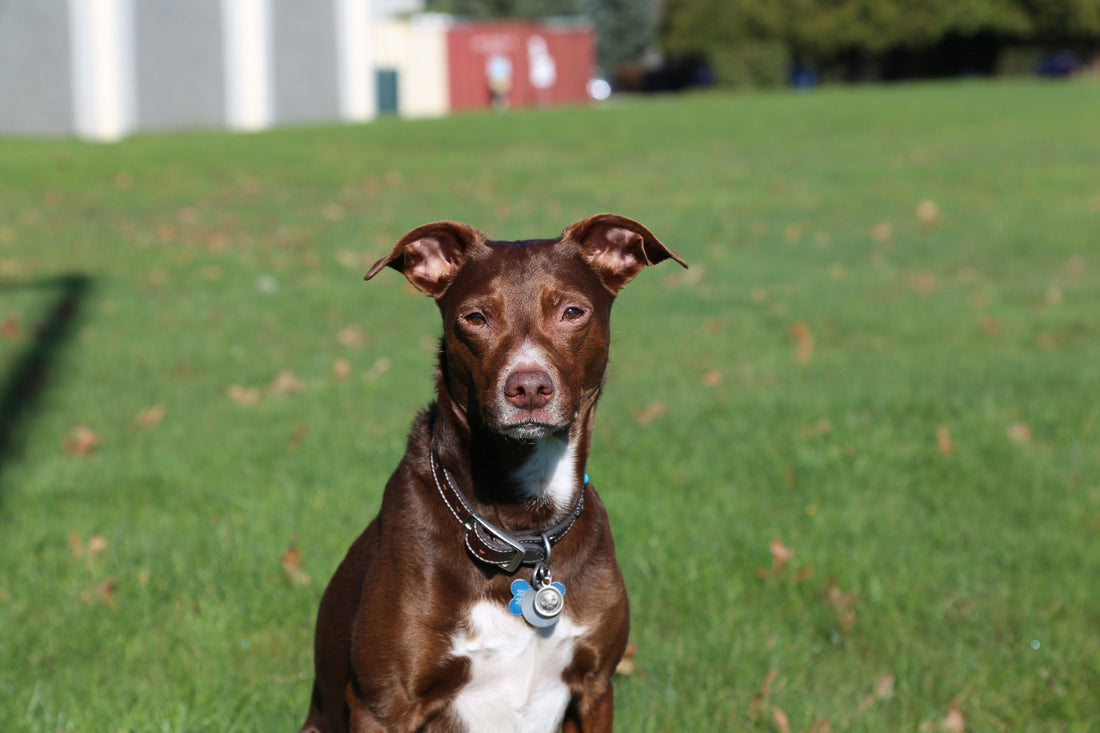
Types of Cancer in Dogs: Treatment & More
Reviewed by Dr. Tori Jones
Cancer in our canine companions is a complex, multifaceted disease that presents a significant challenge for pets and their owners alike. Understanding the intricacies of different dog cancer types and the variety of treatment options available is crucial for navigating this difficult journey. This comprehensive guide aims to shed light on the reality of cancer in dogs, delve into the most common types affecting our furry friends, and explore the treatments that can offer hope and healing when you see the signs that your dog is sick.
The Reality of Cancer in Dogs
The incidence of cancer in dogs is a growing concern, with an increasing number of canine companions being diagnosed each year. It's a disease that spares no breed, age, or size, making it a universal adversary for dogs and their owners. Recognizing the signs of cancer early on and understanding the risk factors involved are critical steps in proactive pet care and management.
Prevalence and Types
Cancer can affect dogs in numerous ways, with a variety of types being reported in veterinary medicine. From skin cancer, known as squamous cell carcinoma, to the more aggressive lymphoma affecting the lymphatic system, the range of cancer types mirrors the complexity of the disease in humans. Each type has its unique characteristics and prognosis, highlighting the need for a tailored approach to diagnosis and treatment.
Risk Factors
Several factors can increase a dog's risk of developing cancer, including genetics, environmental exposure, and lifestyle choices. Breeds such as Golden Retrievers and Boxers are genetically predisposed to certain types of cancer, while exposure to carcinogens, like secondhand smoke or certain chemicals, can also play a role. A healthy diet and regular veterinary check-ups can help mitigate some of these risks, emphasizing the importance of comprehensive health management.
Common Types of Cancer in Dogs
Understanding the nuances of common cancers that affect our dogs is indeed crucial. Lymphoma and mast cell tumors, two of the most prevalent cancers, have a significant impact on the health and well-being of our canine companions.
Lymphoma
Lymphoma in dogs is a form of cancer that originates in the lymphoid tissues, which include the lymph nodes, spleen, and bone marrow. It's a type of cancer that's as complex as it is common, affecting dogs of all breeds and ages. Lymphoma is characterized by the proliferation of malignant lymphocytes, leading to the enlargement of lymph nodes and potentially affecting other organs in the body. Symptoms can vary widely depending on the type of lymphoma and the areas of the body that are involved. In addition to swollen lymph nodes, dogs may exhibit lethargy, loss of appetite, weight loss, and increased thirst and urination.
There are several types of lymphoma in dogs, with multicentric lymphoma being the most common, affecting the lymph nodes. Other forms include alimentary lymphoma, which targets the intestines; mediastinal lymphoma, which involves the organs in the chest; and cutaneous lymphoma, affecting the skin.
Mast Cell Tumors
Mast cell tumors (MCTs) represent one of the most common skin cancers found in dogs, arising from mast cells that play a vital role in the immune system. These cells are involved in allergic reactions and are found throughout the body's connective tissues, making even a single mast cell tumor potentially dangerous due to its unpredictable nature. MCTs can range from low-grade, relatively benign tumors to high-grade, aggressive cancers that can spread to other parts of the body, including the lymph nodes, spleen, liver, and bone marrow.
The appearance of mast cell tumors can vary greatly, with some presenting as small, seemingly innocuous lumps or bumps on the skin, even looking similar to conjunctivitis in dogs when on the eyelids, while others may be more aggressive and rapidly growing. Symptoms may include swelling, redness, and itchiness around the tumor site, and in more severe cases, systemic effects such as vomiting, diarrhea, and anaphylaxis can occur due to the release of histamine from the mast cells.
Treatment Options for Canine Cancer
Navigating the treatment landscape for canine cancer can be daunting for pet owners. However, advancements in veterinary medicine have significantly expanded the options available, offering hope and pathways to remission for many dogs.
Surgery
Surgery stands as a cornerstone in the treatment of various types of cancer in dogs. Its primary goal is to remove tumors physically, which can be curative for cancers detected in early stages or localized to one area. Surgical intervention is often the first line of treatment for cancers such as mast cell tumors and certain types of lymphoma, where complete removal can significantly improve outcomes. The success of surgery largely depends on the tumor's location, size, and type, as well as the overall health of the dog. Post-operative care is crucial, as it helps in recovery and monitoring for any signs of recurrence or metastasis.3
Chemotherapy and Radiation
Chemotherapy and radiation therapy are critical components of the multidisciplinary approach to treating canine cancer, each offering unique benefits in managing this complex disease. Understanding the nuances of these treatments can help pet owners navigate their options more confidently.
Chemotherapy
Chemotherapy employs a variety of drugs to target and kill cancer cells or inhibit their ability to grow and divide. This treatment is systemic, meaning it affects the entire body, making it particularly effective against cancers that have metastasized or are spread throughout multiple locations. In veterinary medicine, chemotherapy protocols are designed to minimize side effects often associated with these treatments in humans. Dogs tend to tolerate chemotherapy better than humans, with only a minority experiencing significant side effects such as nausea, vomiting, and temporary hair loss. The objective of chemotherapy in dogs is not only to extend life but to ensure that the quality of that life is as high as possible.4
The choice of chemotherapy drugs and the duration of treatment depend on the type of cancer, its stage, and the overall health of the dog. Some treatments may involve a single drug, while others require a combination to effectively combat the cancer. Treatments are typically administered in cycles, allowing periods of rest in between to let the body recover.
Veterinary oncologists closely monitor the dog's response to treatment, adjusting the protocol as needed to optimize outcomes while managing any side effects. Supportive care, including medications to help manage nausea and protect the gastrointestinal tract, plays a crucial role in maintaining the dog's well-being throughout chemotherapy.5
Radiation Therapy
Radiation therapy targets cancer cells with high-energy waves, such as X-rays, to destroy or damage them, thereby inhibiting growth and proliferation. This localized treatment is particularly effective for tumors that cannot be completely removed surgically or are inoperable due to their location. Radiation can shrink tumors, relieve pain, and improve quality of life by alleviating the symptoms caused by the tumor's presence.
There are two main types of radiation therapy used in veterinary oncology: external beam (teletherapy) and brachytherapy. External beam radiation is the most common, where a machine directs radiation at the tumor from outside the body. This method is precise, focusing on the tumor to spare surrounding healthy tissue. Brachytherapy, on the other hand, involves placing radioactive materials directly in or near the tumor, providing a high dose of radiation to the cancer cells with minimal exposure to the rest of the body.6
Radiation therapy is often administered over several sessions, with the total number and frequency depending on the tumor's size, type, and location, as well as the radiation type used. While side effects, such as localized skin irritation and hair loss in the treated area, can occur, advances in radiation technology have significantly improved the targeting of tumors, reducing the impact on surrounding healthy tissues.
Both chemotherapy and radiation therapy exemplify the advances in veterinary medicine's ability to treat cancer in dogs more effectively and with consideration for the animal's comfort and quality of life. Through these treatments, coupled with supportive care and nutritional management, dogs with cancer can enjoy longer and more fulfilling lives.
Supporting Your Dog Through Cancer with Natural Pet Products
Throughout the journey of cancer treatment, supporting your dog's overall health and well-being is paramount. This includes providing a diet that helps maintain their strength, immune system, and quality of life. Natural pet food, particularly those tailored for dogs undergoing cancer treatment, can play a crucial role in this support system.
A diet rich in high-quality proteins, healthy fats, and limited carbohydrates can help meet the increased nutritional demands of a dog fighting cancer. Proteins are essential for repairing and building tissue, while healthy fats provide a concentrated energy source. Low carbohydrate intake is often recommended because cancer cells utilize glucose for growth; thus, reducing carb intake can potentially slow cancer progression.
Additionally, diets infused with omega-3 fatty acids, antioxidants, and other beneficial compounds can support immune function and help mitigate inflammation, which is particularly important for dogs with cancer. Omega-3 fatty acids, found in fish oil and flaxseed oil, have been shown to have anti-inflammatory and anti-cancer properties. Antioxidants help protect the body's cells from damage and support overall health.
Natural dog foods that avoid artificial additives, preservatives, and fillers are also important for maintaining optimal health during cancer treatment. These products ensure that your dog is not exposed to unnecessary chemicals that could burden their system.
The journey through canine cancer diagnosis and treatment is indeed challenging, yet advancements in veterinary care and supportive nutritional options offer hope. Integrating effective treatments with supportive care, including a nutritious diet, can make a significant difference in the quality of life and prognosis for dogs with cancer. As research continues and treatments advance, the potential for positive outcomes grows, providing comfort and hope to affected pet dogs and their loving owners.
Sources:
Lymphoma in Dogs
Malcolm Weir, DVM, MSc, MPH; Catherine Barnette, DVM
VCA Animal Hospitals, 2023
https://vcahospitals.com/know-your-pet/lymphoma-in-dogs
Mast Cell Tumors in Dogs
Malcolm Weir, DVM, MSc, MPH; Robin Downing, DVM; Christopher Pinard, DVM; Krista Williams, BSc, DVM
VCA Animal Hospitals, 2023
https://vcahospitals.com/know-your-pet/mast-cell-tumors-in-dogs
The Benefits of Surgery in the Fight Against Veterinary Cancer
Pet Talk
VMBS News (Texas A&M), 2022
https://vetmed.tamu.edu/news/pet-talk/surgery-cancer-treatment/
Chemotherapy for Dogs With Cancer: Common Questions
Mary Kearl
American Kennel Club, 2019
https://www.akc.org/expert-advice/health/chemotherapy-for-dogs-with-cancer/
The Use of Chemotherapy to Prolong the Life of Dogs Suffering from Cancer: The Ethical Dilemma
Tanya Stephens
Animals (MDPI), 2019, Vol. 9(7)
DOI: 10.3390/ani9070441
https://www.ncbi.nlm.nih.gov/pmc/articles/PMC6681408/
Veterinary Radiation Therapy
Animal Cancer and Imaging Center
veterinarycancer.com, 2014
https://www.veterinarycancer.com/radiation-therapy


